
The Agaricales are an order of fungi in the division Basidiomycota. As originally conceived, the order contained all the agarics, but subsequent research has shown that not all agarics are closely related and some belong in other orders, such as the Russulales and Boletales. Conversely, DNA research has also shown that many non-agarics, including some of the clavarioid fungi and gasteroid fungi belong within the Agaricales. The order has 46 extant families, more than 400 genera, and over 25,000 described species, along with six extinct genera known only from the fossil record. Species in the Agaricales range from the familiar Agaricus bisporus and the deadly Amanita virosa to the coral-like Clavaria zollingeri and bracket-like Fistulina hepatica.

The Tricholomataceae are a large family of fungi within the order Agaricales. Originally a classic "wastebasket taxon", the family included any white-, yellow-, or pink-spored genera in the Agaricales not already classified as belonging to e.g. the Amanitaceae, Lepiotaceae, Hygrophoraceae, Pluteaceae, or Entolomataceae.
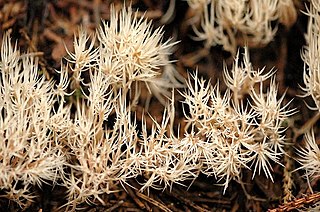
The Pterulaceae are a family of fungi in the order Agaricales. According to a 2008 estimate, the family contained 99 species previously distributed among 12 genera. More recent data from molecular phylogenetic reconstruction showed that members of the genus Parapterulicium are unrelated to Pterulaceae and also polyphyletic. A new genus Baltazaria was created and both genera were moved to Russulales, to families Lachnocladiaceae and Peniophoraceae respectively.

Callistosporium is a genus of fungi in the order Agaricales. Basidiocarps are agarics, either with a central stipe (stalk} or pleurotoid. The latter group were formerly referred to Pleurocollybia. Recent molecular research, based on cladistic analysis of DNA sequences, has shown that the genus is a natural, monophyletic grouping, though not all species have yet been sequenced. Species are saprotrophic, typically growing on wood, and the genus is found worldwide.
Pleurocollybia is a genus of fungi in the family Callistosporiaceae. Basidiocarps are pleurotoid and grow on wood. DNA research has shown that the type species, P. praemultifolia belongs in the genus Callistosporium, making Pleurocollybia a synonym. Not all species have been investigated, however, and it is not clear that every Pleurocollybia species belongs in Callistosporium. Pleurocollybia cibaria has, for example, been transferred to the genus Gerhardtia.
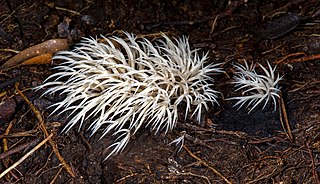
Pterulicium is a genus of fungi in the Pterulaceae family. The genus was previously monotypic, containing the single species Pterulicium xylogenum, found in southeast Asia. However in 2020 a major reclassification of the Pterulaceae family occurred based on phylogenetic analysis and the Pterula genus was split into Pterula, Myrmecopterula, Pterulicium and Phaeopterula by the mycologists Caio A. Leal-Dutra, Bryn Tjader Mason Dentinger and Gareth W. Griffith.
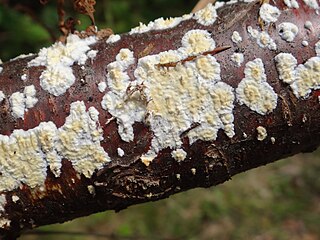
Radulomyces is a genus of crust fungi in the family Radulomycetaceae. The genus has a widespread distribution and contains 11 species. It was circumscribed by Danish botanist Mads Peter Christiansen in 1960, with Radulomyces confluens as the type species. This genus was formally considered to be part of the Pterulaceae family.

Catathelasma imperiale, also known as Catathelasma imperialis, and commonly known as the imperial mushroom, Hutsul mushroom, or korban, is a species of agaric in the family Biannulariaceae. Basidiocarps are stocky, with a double annulus (ring), and a tapering to rooting stipe (stem). The species is ectomycorrhizal with conifers and is found in continental Europe and Asia. Reports from North America are unconfirmed and may refer to Catathelasma evanescens or similar species. Fruit bodies are edible and collected for food in China and elsewhere. The species is widespread but uncommon and is assessed as globally "near threatened" on the IUCN Red List of Threatened Species.
Callistosporium palmarum is a species of fungus in the family Tricholomataceae, and the type species of the genus Callistosporium. Originally named Gymnopus palmarum by William Alphonso Murrill in 1939, the species was transferred to the genus Callistosporium by Rolf Singer in 1944.

Callistosporium purpureomarginatum is a species of agaric fungus in the family Tricholomataceae. Found in the United States, it was officially described in 1996.
David Norman Pegler is a British mycologist. Until his retirement in 1998, he served as the Head of Mycology and assistant keeper of the herbarium at the Royal Botanic Gardens in Kew. Pegler received his BSc from London University in 1960, thereafter studying tropical Agaricales with R.W.G. Dennis as his graduate supervisor. He earned a master's degree in 1966, and a PhD in 1974. His graduate thesis was on agarics of east Africa, later published as A preliminary agaric flora of East Africa in 1977. In 1989, London University awarded him a DSc for his research into the Agaricales.
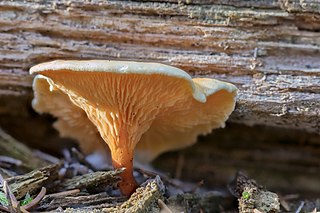
Bonomyces is a genus of fungi in the family Biannulariaceae. Basidiocarps are agaricoid, similar to those of Clitocybe, but with a distinctly hard stipe (stem). The genus is separated on DNA characteristics as well as morphology. Species are known from Europe, North Africa, and northern China.

The Radulomycetaceae are a family of fungi in the order Agaricales.
Radulotubus is a monotypic genus of corticioid or crust fungi in the family Radulomycetaceae containing the single resupinate species Radulotubus resupinatus. This species was found in Yunnan province, China and formally classified in 2016. The specimen was found growing on the fallen trunk of an angiosperm. It was originally placed in the family Pterulaceae and noted to be closesly related with Aphanobasidium and Radulomyces.
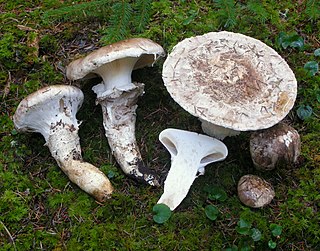
The Biannulariaceae are a family of fungi in the order Agaricales. The family contains three genera. All species form agaricoid basidiocarps. The family was originally described to accommodate the single genus Catathelasma, but has been extended as a result of DNA research.










